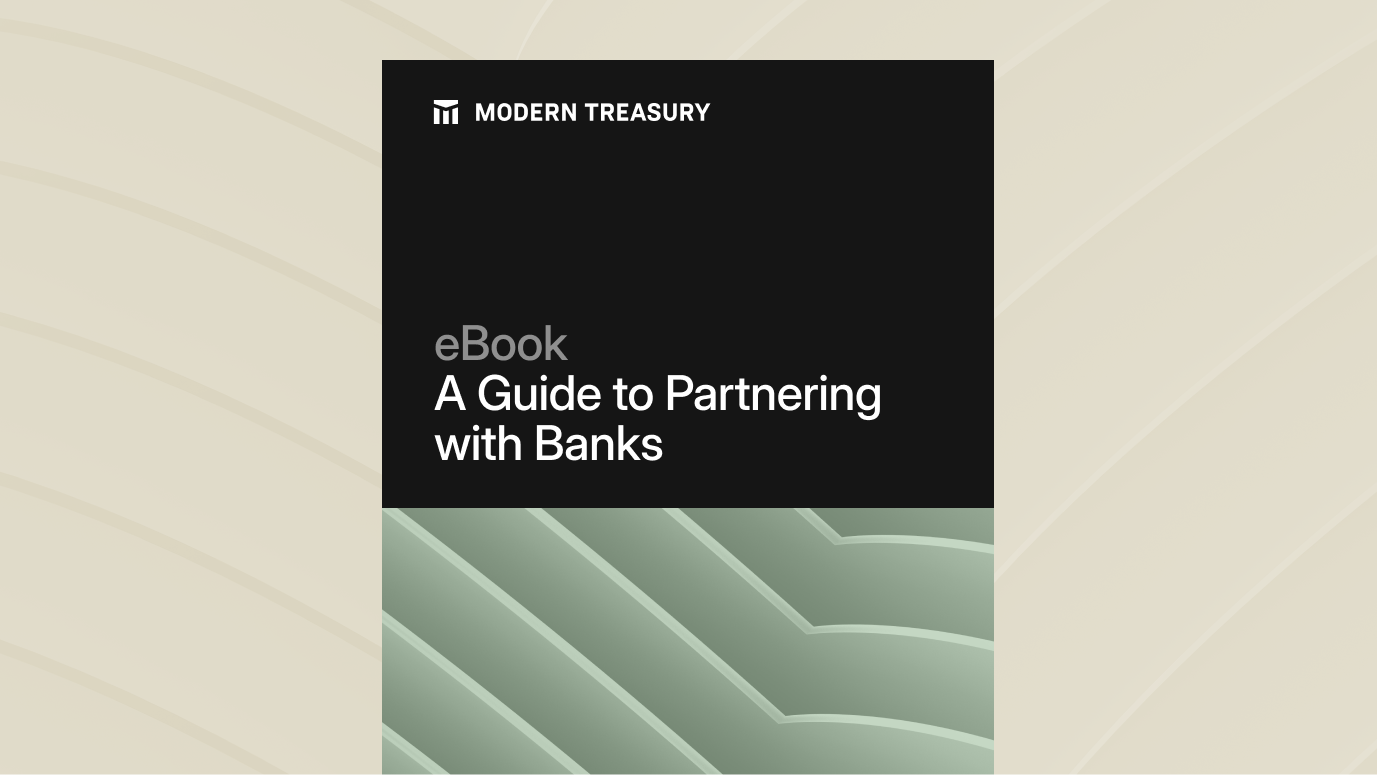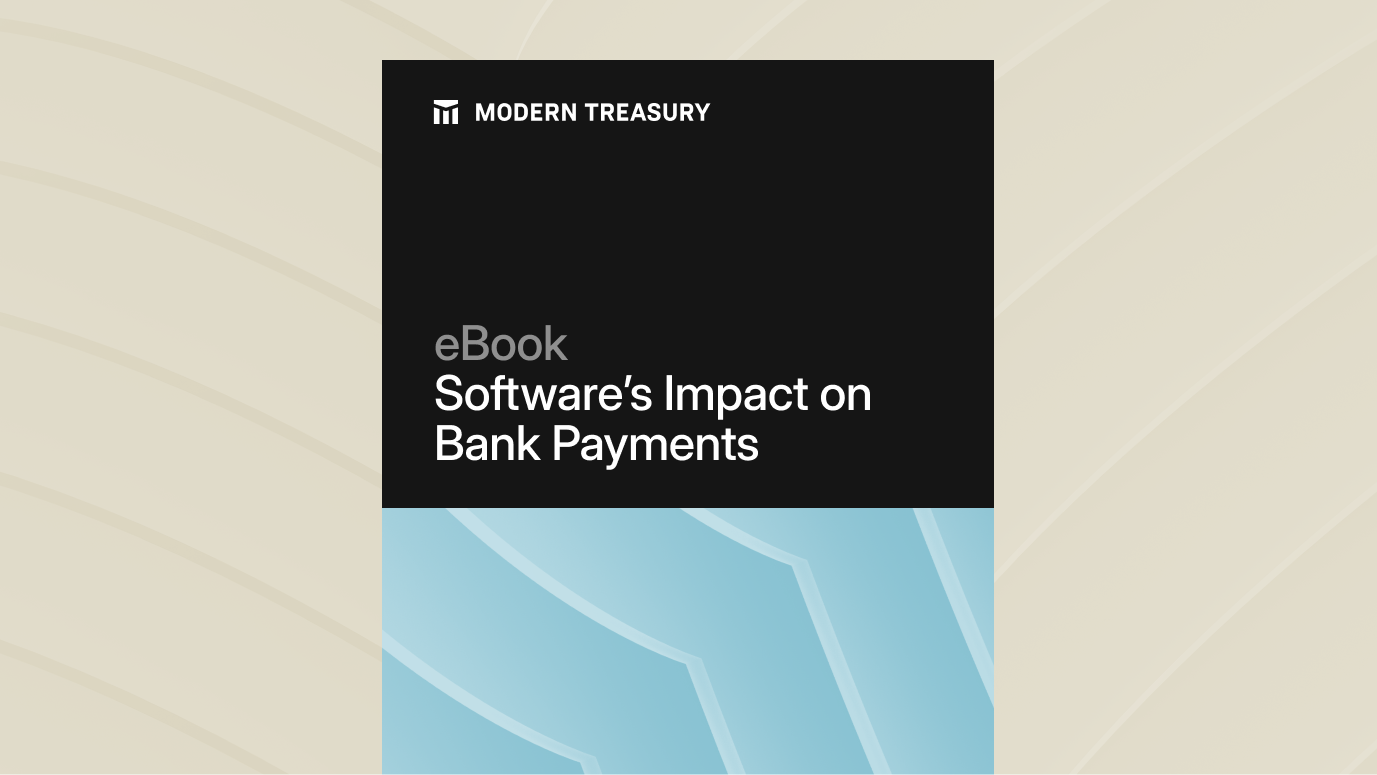Join us at Transfer 2025 to hear how industry leaders are building payments infrastructure for a real-time world.Register Today →
Don't Leave Money on the Table: Why Banks Should Partner with Fintechs
As fintech continues to create value through expanded access to financial services, banks have the opportunity to partner to provide better product support and customer experiences.

The Rise of Fintech
Over the last 10 years, financial technology companies (fintechs) have experienced exponential growth, attracting over $200B in investment in 2021 alone [1]. Several factors have created favorable conditions for fintechs to thrive; consumer adoption of digital finance has accelerated; regulators in the EU and US have broadened open-banking frameworks; and innovation in software and financial infrastructure has made starting a technology company easier than ever before. Angela Strange—a general partner at Andreessen Horowitz—suggests that in the future, “every company will be a fintech company.”
Over the past decade, fintech has created tremendous value by expanding access to financial services, and delivering new experiences to both businesses and consumers. It has also diminished the role of financial institutions, who have struggled to deliver compelling digital experiences to their customers. Without a sufficient response to the changing landscape, banks are leaving a significant amount of value on the table.
The Challenge
Consumers and businesses have heightened expectations for their banks to deliver better tools to address their financial needs.
However, most banks have ways to go in meeting those expectations. While banks like J.P.Morgan and Goldman Sachs have made public commitments to investing in their technology to become tech-forward institutions, others have yet to make similar commitments to transformation. Such that it is, large-scale digital transformation is a complex undertaking that can take years to bear fruit, in many cases with mixed results.
Moreover, financial institutions don’t have the luxury of time when it comes to these initiatives. By 2025, neobanks like Chime and Revolut are projected to reach 20% penetration in the US. Traditional banks also face mounting pressure from a new competitive force: big tech. FAANG companies (Facebook, Amazon, Apple, Netflix, and Google) have not only gained significant market share in the payments space, but are now exploring additional, lucrative segments of banking, such as wealth management [2].
In such a fast-paced and complex competitive environment, banks should consider partnering with fintechs to accomplish their objectives over the next few years. Structured correctly, partnerships carry lower costs and significant upside.
What are the benefits to partnering?
Financial institutions have many strengths. Banks are safe, stable, and solvent. They provide exceptional risk expertise, access to funds that power innovation, and core financial products that undergird entire industries. Partnerships highlight these strengths by addressing potential gaps. We’ve seen three themes that make partnering with fintechs a worthwhile investment.
Support Technical Capabilities
The market is moving towards application programming interfaces (APIs) to support the digital capabilities that business customers expect. These include services such as treasury and liquidity management, bill payments capabilities, account opening, data aggregation, and more.
While some banks have developed sophisticated APIs for certain use cases—bill payments and treasury management services—there are still gaps. For example, there are needs for financial infrastructure to expand beyond payments to support broader commerce and payment journeys.
For many banks, partnering with a fintech company with developer-first API technology may be their best strategy to deliver a best-in-class client experience.
Expand Product Offering
Additionally, banks face challenges bringing new solutions to market. This is another area where fintech partnerships can help. By partnering with fintech companies, banks are able to release solutions, such as digital wallets, virtual accounts, push to card, request for payment (RFP), even crypto capabilities more quickly and with less resource investment.
Unlock Highly-Profitable Customer Segment
Lastly, fintech partnerships can help banks unlock new customer segments and revenue streams. Dynamic, high-growth companies in today’s economy (e.g., vertical software, fintech and marketplaces) have financial needs that extend beyond current bank capabilities. For example, platforms are often looking for integrated solutions that automate or streamline an entire business process—stitching together compliance, onboarding, payment tracking and reporting, reconciliation, ledgering and other capabilities. Banks that lack these offerings risk losing clients to other banks or third-parties.
Again, fintech partnerships here can help. Fintech partnerships offer the tools to address these clients' needs. They also signal to the market that the bank is excited to win new, dynamic clients.
Already, we’ve seen strong evidence that innovative, technology companies are a profitable client segment for banks. These companies have strong fee-revenue profiles, substantial deposits, lower loan utilization, and high growth. Banks that have prioritized these segments, such as Silicon Valley Bank, First Republic, and Silvergate, have demonstrated outsized growth; together, they report an EPS growth rate (CAGR) that is 340% higher than that of traditional banks [3].
How Should Banks Think about Partnering with FinTechs?
As discussed above, there are strategic and operational benefits for banks to partner with fintechs. Banks, however, must decide upon a partnership model that best achieves their objectives.
In our experience, we see three partnership models that banks should consider: pure referral, integrated referral, and integrated product offering.
Pure Referral
Referral partnerships are the fastest way to deliver value through a partnership. Under a referral partnership model, both the bank and fintech retain their separate product, support, and billing relationships with clients. Nevertheless, these separate relationships should be supportive, and coordinated to be successful.
For referral partnerships, we’ve found that deep alignment drives the greatest success. Both bank and fintech should understand the specific target audience, the use case, and partnership value proposition.In addition, both parties should align on the client buyer journey, and collaborate on an operating model that ensures shared clients are successful.
Referral partnerships are lightweight. In most cases, both parties can begin driving mutual business with a non-disclosure agreement, a partnership operating framework, and sales enablement activities. However, because these partnerships lack a strong product integration, deeper levels of partnership value may remain out of reach for this type of relationship.
Integrated Referral Partnership
Integrated referral partnerships take referral partnerships a step further by introducing a product integration. Integrated referral partnerships, offer product synergies that support the overall partnership value proposition. Like pure referral partnerships, both the bank and fintech have separate support and billing relationships with their clients.
Compared to pure referral partnerships, integrated relationships are more involved. However, they also deliver higher strategic value, and are more sustainable over the longer term. To structure a strong integrated referral partnership, both parties should define a common vision, collaborate on a joint product offering, and create a cohesive go-to-market (GTM) strategy that articulates a compelling value prop to a specific customer segment. Success involves cross-functional sponsorship, product collaborations, and joint GTM motions with co-branded materials.
Integrated Product / Offering Partnership
Lastly, integrated partnerships incorporate a partner’s product or services as part of a holistic product offering. For example, this can be a co-branded “reseller” partner relationship or a “white-labeled” relationship in which the partner’s product is branded within the bank’s offering (e.g., Bill.com powering AP payments for a bank’s customers). These relationships afford banks a higher degree of control over the product, pricing, support relationships and more.
Integrated partnerships are complex. They require significant operational efforts to execute, and a well-structured agreement that covers everything from performance service level agreements (SLAs), to support arrangements, to economics. However, these upfront investments can deliver deeper levels of partnership value over the long term, as this structure creates stronger product alignment and often more clear incentives and ownership.
Next Steps
As technology moves into new areas of the economy and workflows digitalize, clients’ technology needs will continue to expand. Banks will have to make a decision: either commit to building new infrastructure themselves or partner with a financial technology company to help support those capabilities.
At Modern Treasury, we have built a flexible software platform to help banks accelerate their goals and address the needs of their clients.
To learn more, please reach out to banks@moderntreasury.com.
SNL Financial, Capital IQ, 2022
Try Modern Treasury
See how smooth payment operations can be.







